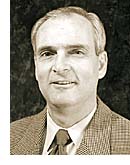


View
A Time for Everything
by W.G. Nelson
 Two
of life’s absolutes seem to be the opposing forces of continuity and
change. This is especially true on a college campus where the physical reminders
of the past are always present as we go about the business of educating the
current generation of students. And there is no more cherished campus symbol
of continuity than the Administration Building which has housed classes and
administrative activity during every academic term since Walla Walla College
first opened its doors.
Two
of life’s absolutes seem to be the opposing forces of continuity and
change. This is especially true on a college campus where the physical reminders
of the past are always present as we go about the business of educating the
current generation of students. And there is no more cherished campus symbol
of continuity than the Administration Building which has housed classes and
administrative activity during every academic term since Walla Walla College
first opened its doors.
I learned early in my time in College Place just how fondly this building was regarded. I was cornered at an alumni gathering by one well-intentioned graduate of the first half of the twentieth century who pointedly told me that if I wished to continue as president of the college for more than a fleeting moment, I would do well to “keep [my] hands off of the Ad building.”
Not long after that conversation, however, WWC was required to do a seismic study to determine how well campus structures would endure in an earthquake. The data gathered by the engineers reaffirmed the conclusions of several previous studies done by Emeritus Professor Edward Cross. The old building had significant structural problems which had to be addressed in order to meet current health and safety standards.
Much study has been given over the past five years as to the best way to address the necessity of campus facility renewal. It was determined that the Ad Building should be the number one priority. Architectural studies were commissioned to consider the options and costs of renovation and restoration as contrasted with those of replacement. The conclusions of this analysis were then shared with campus and board committees. Early deliberations favored the possibility of total or partial renovation. The cost estimates of this process, when compared to those of constructing a new building led to a reluctant consensus favoring the option of replacement. The WWC Board of Trustees subsequently voted to move ahead in the process of developing the plans for the construction of a new administrative building and of gathering the resources to support this concept.
The past several years have been spent quietly acting on this directive. Alumni focus groups have helped us determine that the new building should be constructed in the footprint of the current building and that it should be architecturally evocative of its predecessor. Alums have made it clear that when they visit the campus they want to be able to look up the hill from College Avenue and see the familiar columns which stir so many pleasant memories. Plans for the new building bear a striking resemblance to the original structure, and this will serve as a perpetual visual reminder to all that we still have faith in the vision which came to be WWC. We have also been gratified by the number of alumni and friends who have already stepped forward to make pledges which will significantly assist in making these plans a reality.
Planning has now progressed to the point where it is appropriate to have a special celebration of the Ad Building before it is vacated to make way for construction. This service will take place on Sabbath afternoon, April 28, of the 2001 Alumni Weekend. This will be a time to reflect on the history of the college, how the Lord has blessed it, and how that blessing was often connected to this historic structure.
Ecclesiastes 3:1, 3 (NIV) suggests that “There is a time for everything, and a season for every activity under heaven … a time to tear down and a time to build …” Such activities are both exhilarating and emotionally draining, and I expect that everyone connected with WWC will experience elements of both as we proceed with our plans for the campus over the next few years. I am also sure that we will gain a renewed sense of the Lord’s continuing presence as we take concrete steps to ensure the future of the educational mission for which WWC was established.
W. G. Nelson is president of WWC.